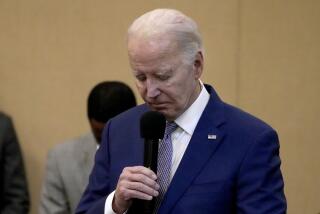Obama administration agrees to informal drone halt in Pakistan
WASHINGTON -- The Obama administration has agreed to Pakistan’s request to stop drone-launched missile strikes except on Al Qaeda operational leaders while Islamabad pursues peace talks with local Taliban militants, U.S. officials say.
The informal pause began in late December, seven weeks after a CIA drone strike killed Pakistani Taliban leader Hakimullah Mehsud just as negotiations were set to begin, drawing an angry rebuke to Washington from Prime Minister Nawaz Sharif’s government.
The stand-down on targeted killings of Taliban leaders in Pakistan “doesn’t impact our list for core Al Qaeda,” a U.S. official said Wednesday, speaking on condition of anonymity about a covert program. “They still have a green light on Al Qaeda targets.”
Those targets are fewer these days because Al Qaeda’s leadership in northwest Pakistan is increasingly thin on the ground after more than a decade of drone strikes and other counter-terrorism operations, including the killing by Navy SEALs of Osama Bin Laden in May 2011.
The CIA has not launched a drone strike in Pakistan since Dec. 25 -- the longest lull since a six-week halt in November 2011 after U.S.-led NATO forces mistakenly killed 24 Pakistani soldiers on the border with Afghanistan. That strike worsened the diplomatic tensions with Washington that began with the cross-border raid that killed Bin Laden.
The informal agreement to sharply curtail drone strikes was first reported Tuesday by the Washington Post. The pause apparently does not affect surveillance flights.
The CIA declined comment Wednesday. A senior Obama administration official said the United States is “continuing to aggressively identify and disrupt terrorist threats in the Afghan war theater and outside of areas of active hostilities. ... This remains our policy.”
External factors may limit future drone strikes in any case.
Afghan President Hamid Karzai has refused to sign a bilateral security agreement to let U.S. troops remain in Afghanistan after the end of 2014. Unless the accord is signed by Karzai or his successor, to be chosen in April elections, all U.S. troops will be withdrawn, including those who now run the airfields where armed drones are based.
If those bases close, U.S. drones could be flown over Pakistan from more distant facilities or ships. That makes attacks far more difficult, although not impossible, officials say.
The Pakistani Taliban has been designated by the State Department as a terrorist organization. Although it has launched most of its attacks inside Pakistan, it also has mounted lethal attacks on U.S. troops and facilities in neighboring Afghanistan. It is not directly affiliated with the Afghan Taliban, however.
Mehsud, who was killed on Nov. 1, had claimed responsibility for organizing the December 2009 suicide bombing of a secret CIA outpost on a U.S. military base in Khowst, in eastern Afghanistan, that killed seven CIA officers.
Mehsud’s group also claimed responsibility for a failed attempt to detonate a car bomb in New York’s Times Square in May 2010. The U.S. government had put a $5-million reward on his head.
But the Pakistani Taliban is not considered as dangerous to U.S. interests as Al Qaeda, which still seeks to target the United States. Last week, Sharif announced that the peace talks canceled in November after the Mehsud killing were back on track, although formal talks have not yet begun.
The pause in strikes is a sign, U.S. officials say, of President Obama’s effort to scale back the covert drone war. But the official secrecy that surrounds the program, critics say, shows the administration still resists explaining it in public.
“Whatever signal the White House is reportedly trying to send, it’s totally garbled by the official secrecy over killings,” said Naureen Shah, who tracks the program for Amnesty International, which views many of the drone strikes as illegal. “The way forward is to be transparent about the policy and accountable for the unlawful killings we know have occurred.”
In a major speech last May, Obama announced narrower targeting standards for drone attacks to help protect civilians. The White House defended those rules Monday after Rep. Mike Rogers (R-Mich.), chairman of the House Intelligence Committee, argued they were making Americans less safe.
The White House also said it would seek to transfer most drone operations out of CIA hands to the Pentagon. But military operations come under different laws than intelligence, and opponents in Congress passed a classified amendment to a spending bill that effectively barred the administration from making the shift.
Although Obama also promised more transparency about drone strikes, U.S. officials rarely disclose or confirm details about missiles launched by the military or the CIA.
On Tuesday, Rep. Adam Schiff (D-Burbank), asked CIA Director John Brennan at a House Intelligence Committee hearing why the U.S. couldn’t make an annual disclosure of how many militants and how many civilians have been killed in targeted attacks.
Brennan made no promises.
“I think it would be a recommendation that would have to go to the administration, and I would be a participant in the inter-agency process to discuss the potential advantages and potential disadvantages of it,” he said. “It is certainly a worthwhile recommendation if you would like to make that.”
Twitter: @kendilanianLAT
More to Read
Start your day right
Sign up for Essential California for news, features and recommendations from the L.A. Times and beyond in your inbox six days a week.
You may occasionally receive promotional content from the Los Angeles Times.







